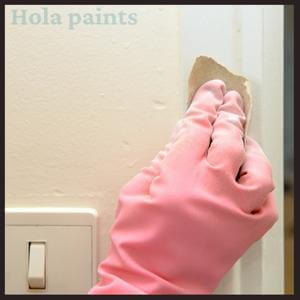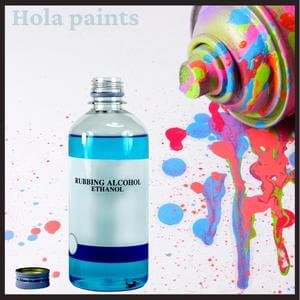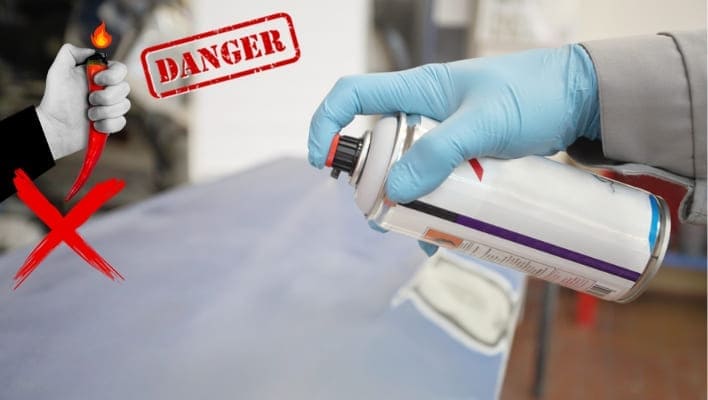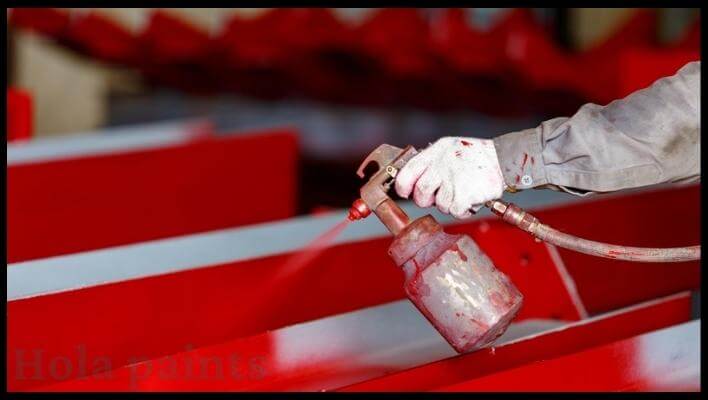Using spray guns for any paint job is quite convenient and simple and there is no doubt that spray painting speeds up the process. However, spray paint leaves a trail behind. Dripping paint on plastic surfaces, such as handles, furniture, light switch covers, or uncovered appliances spoils the pleasure of a paint job.
Most of us struggle with the removing spray paint from plastic, so I researched to find a solution. Fortunately, with the right tools and proper guidance, one can easily learn how to remove spray paint from plastic.

Table of Contents
- Removing spray paint from plastic
- Material Requirements
- How To Remove Paint From Plastic? (Step-By-Step Guide)
- Rinsing With Water
- Using Soap For Scrubbing
- Mix Paint Thinner and Water to Remove Paint
- Increase the amount of Paint Thinner
- Getting Rid of Excess Paint
- How to remove Spray paint from plastic with nail polish remover?
- Rubbing alcohol vs Denatured alcohol
- Remove Dried Paint With Rubbing Alcohol
- How to Remove Spray Paint from plastic with Denatured Alcohol?
- How does WD-40 remove paint from plastic?
- How do you remove paint without damaging plastic?
- Conclusion on How to remove spray paint from Plastic!
- FAQs on How to remove paint from Plastic
- How to remove paint from plastic without scratching?
- How to remove spray paint from plastic using household items?
- How to remove Spray Paint from plastic with Oven cleaner?
- How do you remove paint from plastic car trim?
- How to remove dried paint from plastic bucket?
- How to get paint off plastic in any effective way?
- How to remove rustoleum spray paint from plastic?
- Does acetone dissolve spray paint?
Removing spray paint from plastic
Material Requirements

Be aware that plastic is easily damaged and a single mistake could harm the whole plastic layer. So, it needs to be handled carefully. Here’s the guide on how to get spray paint off plastic.
The materials necessary for removing paint from plastic are outlined in this section. Most of these items are probably available at home, so you don’t have to buy any of them.
Warm Water
There will be a need for warm water throughout the procedure, so stock up on it before you begin. Using warm water can help loosen paint layers, making the whole process a lot easier.
It can also be mixed with paint thinners and soap for greater results. Moreover, water will protect any surface from the effects of chemicals in paint removers.
Soap
A bar of soap will be your next item, which can be any dish soap. You can remove semi-wet paint with soap and scrub it off. Additionally, it will remove any dirt that may have accumulated on top and helps to keep the surface clean.
Sponge
You can use a sponge to clean plastic or any other surface. Since the sponge is soft, it will not harm plastic. In addition, it is good at absorbing liquids, including alcohol, so it’s a great choice for removing paint application.
Towels
As an alternative to a sponge, you can use a rag, cloth towel, or paper towel for scrubbing and cleaning the paint. It will keep the surfaces clean and help you avoid messy situations.
Brush
If paper towels fail to do the job, you will need brushes. They will allow you to scrub the surface well and help you clean more intensively.
Plastic safe paint remover
In general, this is the last choice due to its strong effects on plastic layers. You should add paint thinner in a separate container to dilute it with water. Do not use this in concentrated form as it may damage plastic.
How To Remove Paint From Plastic? (Step-By-Step Guide)
The materials you need are all in your hands, so it’s time to begin working. Getting rid of spray paint from plastic can be tricky, but here are the steps you need to follow.
Rinsing With Water
Rinsing is always a good idea during paint removal projects. For this purpose, warm water is more effective than cold water at normal temperatures, so water has to be warmed up before use.
In case there are any wet parts, get rid of them before you use stronger cleaners like soap and paint thinner. As it may spread the paint to a larger surface area, making your job more difficult.
Using Soap For Scrubbing
Take some soapy water and scrub off the paint if it is still present on the plastic. Some of the paint should come off as you scrub with a brush. Also, you can apply elbow grease with a brush to remove dried paint.
When working with thin plastic, you should use a brush with soft bristles. Otherwise, if the plastic is scratched, it may become unattractive.
Mix Paint Thinner and Water to Remove Paint

If paint remains, you’ll need to use a plastic paint remover. Generally, paint thinner comes in concentrated form, and it can damage plastic if you use it too much.
Ideally, the solution should contain 20% paint thinner and 80% water, and this must be tested first by applying the paint thinner on a plastic corner.
If it does not damage the affected area drastically, you can use the mixture to remove the other painted portions.
Increase the amount of Paint Thinner
When you still can’t remove the paint, add more paint thinner and then test small areas before applying to entire surface.
Getting Rid of Excess Paint
Once the paint becomes liquid again, it needs to be wiped off. You can use a semi-rough cloth to remove the paint.
How to remove Spray paint from plastic with nail polish remover?
Put nail polish remover on a paper towel and rub the painted area to remove spray paint. then let it dry for 5-10 minutes. The paint should start to fade at this point. Otherwise, you should try denatured alcohol instead if it doesn’t work.
Rubbing alcohol vs Denatured alcohol

Rubbing alcohol contains natural ingredients and usually does not harm the skin while working with the denatured alcohol, you may experience skin irritation, so it is best to wear rubber gloves when working with it.
Remove Dried Paint With Rubbing Alcohol
Gather Materials:
Acquire rubbing alcohol (95% to 99%), a paint scraper, a soft cloth, and a sponge.
Test in a Small Area:
Apply rubbing alcohol to a small portion of the plastic to verify it won’t harm the surface.
Apply Rubbing Alcohol:
Moisten a soft cloth or sponge with rubbing alcohol.
Gently Rub the Stain:
Carefully rub the spray paint stain with a cloth or sponge. Alternatively, use a paint scraper for scraping off the paint. Be cautious to avoid excessive pressure and prevent scratching.
Wipe Away Paint:
As the paint begins to loosen, wipe it away with a cloth. Repeat the process until the dried paint is completely removed.
Rinse and Dry:
Rinse the plastic with water to remove any alcohol residue. Dry thoroughly with a clean, dry cloth.
How to Remove Spray Paint from plastic with Denatured Alcohol?
It’s easy to remove spray paint from plastic with denatured alcohol. The denatured alcohol should be rubbed into the paint by using a clean rag. To make sure that denatured alcohol does not harm your plastic, test it on a small area first. After that, use the damp paper towel to wipe the paint away after the denatured alcohol loosens it.
How does WD-40 remove paint from plastic?
You can apply vegetable oil, motor oil, WD-40, etc for removing freshly dried paint. Simply softening the paint off will do the trick. You can learn step by step process on removing paint from plastic with WD-40 in this detailed guide.
How do you remove paint without damaging plastic?
It is challenging to remove paint from plastic surfaces since many paint removal methods can damage the plastic or melt it. There are a few ways to safely remove paint from plastic:
- Sandpaper: Use fine-grit sandpaper to sand the paint away gently, but make sure not to damage the plastic by sanding too deeply.
- Solvents: It is possible to soften and remove paint from plastic with the aid of solvents such as mineral spirits, acetone, or denatured alcohol. However, some solvents may cause the plastic to soften or warp, so test on a small area first.
- Soap and water: Warm water and mild dish soap can work well to soften and remove water-based paint. Using a soft-bristle brush, rub off the paint gently and wipe it off using a damp cloth.
- Heat gun: Use a heat gun to melt the paint, then scrape it off with a plastic scraper. Heat guns need to be kept moving to avoid overheating plastic.
- Plastic safe paint strippers: You can purchase paint strippers specifically formulated to remove paint from plastic.
Plastics are delicate, and may not be able to withstand certain paint removal techniques. You should always start by removing paint from an inconspicuous area before moving on to larger surfaces.
Conclusion on How to remove spray paint from Plastic!
There is always the risk of damaging plastic when removing paint from plastic surfaces. Thus, remember to be more careful when you use it next. Also, it’s important to cover everything before applying spray paint. Moreover. If you have already gotten paint on plastic, try to clean it promptly.
Thank you for reading this article about how to remove spray paint from plastic. We know that getting spray paint off of plastic takes some effort, but you will be pleased with the outcome.
FAQs on How to remove paint from Plastic
How to remove paint from plastic without scratching?
You can buy rubbing alcohol almost anywhere if you need to clean tough paint spills from plastic. The use of rubbing alcohol helps remove paint from plastic without melting it, while harsh paint thinners cause the plastic to melt.
How to remove spray paint from plastic using household items?
Rubber alcohol, nail polish removers, liquid dish soap, detergents are all effective household cleaners for removing paint that is later scraped off with a plastic putty knife or a razor blade.
How to remove Spray Paint from plastic with Oven cleaner?
Oven cleaner removes paint just like it takes away dirt and grime. It loosens the paint so that you can easily remove it. You can apply oven cleaner on the painted surface and let it sit for a couple of hours, then repeat the process if needed.
The bubbles should appear once the cleaner is applied. You can scrape the paint with a plastic putty knife when it begins to bubble.
How do you remove paint from plastic car trim?
You can remove spray paint from plastic car parts by using Acetone. For this purpose:
Soak a clean cloth in acetone and wipe down the affected area with it. As it will dry naturally, there will be no dirt or oil left on the surface of the plastic.
How to remove dried paint from plastic bucket?
Step 1 Take a dull knife and scrape away dried paint.
Step 2 Wet the dried paint thoroughly with rubbing alcohol and remove any leftover dried paint.
Step 3 After the alcohol has sat for a few minutes, wash the dried paint on the surface with a rag.
Step 4 After rinsing out the alcohol from the bucket, wipe it with a clean rag.
Step 5 If any stubborn dried paint remains, remove it with a rag and latex paint remover. After cleaning the bucket, rinse it well.
How to get paint off plastic in any effective way?
A putty knife can be used to gently remove paint (tip: you can soften the paint with vegetable oil). On harder areas, you can try denatured alcohol or acetone, but always spot test first. You can also wash the plastic with warm water and soap.
How to remove rustoleum spray paint from plastic?
It is also possible to buy rubbing alcohol (isopropyl alcohol) almost anywhere, even on Amazon, for really stubborn paint spills. It is safer to remove paint with rubbing alcohol rather than with harsh paint thinners.
Does acetone dissolve spray paint?
Yes, acetone is a highly effective solvent to remove spray paint. Many paints can be dissolved and softened with acetone, even if they have hardened. Using a cotton ball soaked in acetone and rubbing against the stain will easily remove the paint.

Jennifer Marie
Jennifer Marie is a general contractor with over the years of experience in home remodeling, DIY projects, and commercial painting projects. Her experience includes working with paint sprayers, painting tools, and other painting supplies. You can follow her on Facebook.


